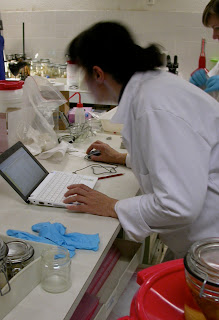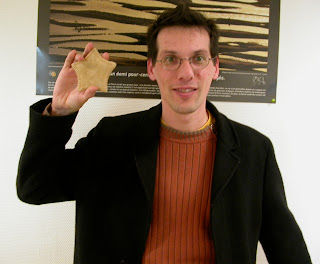 For the last 3 weeks, I've been blogging from the Museum national d'Histoire naturelle (MNHN) in Paris France.
For the last 3 weeks, I've been blogging from the Museum national d'Histoire naturelle (MNHN) in Paris France.As indicated in a prior post, I've been working on the diversity of starfishes in the invertebrate collection, looking for new species and additional data for my research.
 The MNHN is the French equivalent of the Smithsonian Institution's National Museum of Natural History in the United States, and carries an equally esteemed reputation for research excellence.
The MNHN is the French equivalent of the Smithsonian Institution's National Museum of Natural History in the United States, and carries an equally esteemed reputation for research excellence. In spite of its incredible age (founded in 1793, making it nearly 220 years old!), the museum has shown no signs of slowing down and hosts a number of modern, cutting edge research laboratories that work on ecology, deep-sea biology, paleontology, and more!
In spite of its incredible age (founded in 1793, making it nearly 220 years old!), the museum has shown no signs of slowing down and hosts a number of modern, cutting edge research laboratories that work on ecology, deep-sea biology, paleontology, and more!Usually, when someone like me visits a museum as a researcher, I am hosted by a research lab, in this case-the Echinoderm laboratory at the MNHN which is headed by Dr. Nadia Ameziane!
Her lab works primarily on crinoids (i.e., the feather stars) but has included work on sea urchins (asteries) and sea urchins (oursins). Much work is done in the Antarctic and in the deep-sea-but scope of the lab is global.
Dr. Nadia Ameziane. Nadia has been a curator at the MNHN since the early 90s and has been very influential in the growth of the echinoderm collections in Paris throughout the last two decades. She oversees the people and echinoderm research at the museum...
 and is one of the world's experts on the evolution and diversity of living stalked crinoids. Her papers include this recent one in conjunction with Marc and Lenaig (below) which I blogged about here. Other papers include this one , this one and this one!
and is one of the world's experts on the evolution and diversity of living stalked crinoids. Her papers include this recent one in conjunction with Marc and Lenaig (below) which I blogged about here. Other papers include this one , this one and this one!Nadia does just about everything!
She oversees the MNHN Echinoderm site, advises students, helps to manage the invertebrate zoology collections, attends committee meetings, and of course, continues to do her science. I tried to catch a picture of Nadia above-but she was busy preparing for an Antarctic cruise to Adelie Land (aka Terre Adelie)!!

Dr. Marc Eleaume got his Phd in 2006 from the Museum national D'Histoire naturelle (yes-they actually grant degrees!) and was promptly hired by the museum about one year later.
Marc is sort of the First Officer of the lab/echinoderm collection. Sort of Commander Riker to Nadia's Captain Picard. He takes care of a lot of the day to day while she manages her senior duties.
Marc is sort of the First Officer of the lab/echinoderm collection. Sort of Commander Riker to Nadia's Captain Picard. He takes care of a lot of the day to day while she manages her senior duties.
 Marc also works on the evolution and diversity crinoids, especially those in the Antarctic. He focuses on their evolution and taxonomy, but also their ecology and community structure (see one of these papers here). I blogged about one of his papers on crinoid current flow only about a month ago, here.
Marc also works on the evolution and diversity crinoids, especially those in the Antarctic. He focuses on their evolution and taxonomy, but also their ecology and community structure (see one of these papers here). I blogged about one of his papers on crinoid current flow only about a month ago, here.Marc is currently in the process of describing a new genus and species of Ptilocrinus (which is in the jar he is holding), a stalked crinoid from the Antarctic to be published in the journal Polar Science.
Marc speaks excellent English and has been instrumental in organizing logistics for the many English-speaking scientists who visit the museum. I (and many others) owe him a huge debt for arranging any number of important details.
Once, many years ago, Marc pointed out that what I thought was laundry detergent was actually bleach! Thus preventing my looking like I had lost a fight with a bottle of white-out!
Always good to have someone who can read French when visiting France. :-)
Ms. Lenaïg Hemery. The youngest member of the lab is Lenaig, a PhD student from Brittany (in the northwest of France).
 Lenaig is working on multiple big projects in crinoid phylogeny in conjunction with Marc and Nadia.
Lenaig is working on multiple big projects in crinoid phylogeny in conjunction with Marc and Nadia.Including a phylogeography of the Antarctic crinoid Promachocrinus kerguelensis...
 but perhaps her most impressive achievement is one of the most comprehensively sampled and most complete of the DNA phylogenies of the crinoids (i.e., a family tree, including feather stars and sea lillies)!!!
but perhaps her most impressive achievement is one of the most comprehensively sampled and most complete of the DNA phylogenies of the crinoids (i.e., a family tree, including feather stars and sea lillies)!!!Here, Lenaig holds the output of her tree which includes 200 taxa (i.e., species) and is based on 4 genes.
 The tree represents a HUGE accomplishment when she finally gets her PhD thesis done! Extracting DNA from crinoids isn't easy...neither is identifying them..with Marc and Nadia's help, it seems like Lenaig's project will be a huge success!
The tree represents a HUGE accomplishment when she finally gets her PhD thesis done! Extracting DNA from crinoids isn't easy...neither is identifying them..with Marc and Nadia's help, it seems like Lenaig's project will be a huge success!A Visit from Dr. Villier...
 Loic works on the evolutionary patterns of different fossil marine invertebrates, but is particularly fond of fossil sea stars and the evolution. He has a particular fondness for goniasterid sea stars (such as the Ceramaster he's holding), which readily fossilize in northern Europe....but sometimes only as individual pieces, which can make working with them a challenge... (here to see a blog about it)
Loic works on the evolutionary patterns of different fossil marine invertebrates, but is particularly fond of fossil sea stars and the evolution. He has a particular fondness for goniasterid sea stars (such as the Ceramaster he's holding), which readily fossilize in northern Europe....but sometimes only as individual pieces, which can make working with them a challenge... (here to see a blog about it)That said, Loic describes quite a few complete fossil starfish, largely from the Mesozoic. Examples of some of his recent papers are here, here and here.
Loic's newest paper (VILLIER, L.: Asteroids from Barremian calciturbidites of the Serre de Bleyton (Drôme, SE France). 701-732, 1 pl., 10 figs, 2 tabs) describes this awesome looking beast: Leptaster martinii, described by deLoriol in 1880 in the Middle Jurassic!
Fossils of this quality are VERY rare.
But this one, has a particularly unusual collection history!
This was told to Loic by Dr. Jean-Henri Delance (1937-2005) who worked as specialist in fossil brachiopods and quantitative paleoecology at the University of Burgundy.
He also was the curator of the paleontological collection at the University of Burgundy and responsible for the University Museum, the so-called "Jardin Jurassique".
Early in his career, Jean-Henri had been working in the quarry of the village Comblachien, south of Dijon (France), doing paleocological investigation of several small coral and bryozoan patch reefs. Jovial and friendly with everybody he has been invited by one of the quarryman for a drink at home. While sitting at the kitchen table and waiting for glasses and a bottle, his eyes focused on the hot pad lying in the center of the table. This was a squared limestone block perfectly jagged and polished, cut in the mid-plane of a fossil sea star. Jean-Henri managed to deal it for several bottles of Burgundy wine, and added the "sea star hot pad" to the paleontological collections of the University.
The sea star can be identified despite its uncommon mode of preservation. This is the third specimen available for the Jurassic taxon Leptaster martinii de Loriol (1880). The cross section offers a rare opportunity to described the articulation pattern of all ossicle types, and this is the reason why I have chosen to illustrate this specimen in a discussion on systematic affinities of Leptaster.
Whew! Christmas is coming up! and I'm leaving Paris soon...so look for next week's blog to be late and probably a little light as I am en transit....
Hope all of you are having a great holiday time!



1 comment:
Great ! I did a 2-months internship with Nadia last year making a database on antarctic asteroids, and your Echinoblog was very useful... keep posting ! ;)
Post a Comment